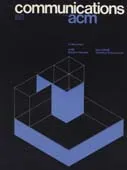June 1979 - Vol. 22 No. 6

Features
An implementation of structured walk-throughs in teaching Cobol programming
The effectiveness of structured walk-throughs in teaching introductory Cobol programming was empirically assessed with a sample of 215 undergraduate business administration majors. Cobol proficiency was measured by a final examination testing (a) knowledge of language rules, (b) ability to read and debug a program, and (c) the ability to write a program. Analysis of multiple covariance was used to statistically adjust test scores for age and conditional reasoning scores.
The findings provide empirical support for incorporating structured walk-throughs into the programming learning process to more effectively develop student proficiency in writing Cobol programs.
An academic program providing realistic training in software engineering
An academic program at Harvey Mudd College, called the Clinic program, brings projects from industry on campus to be studied and solved by student teams. The objective of the Clinic is to provide students, working as small teams under careful faculty supervision, an opportunity to work on real world problems of sufficient magnitude and complexity. Under this program, students can acquire essential skills of software engineering, such as team work, software project management, software design methodology, and communication skills, in a realistic environment. Sample software projects undertaken by the Clinic are described. Experience so far has shown that the program is a viable transition from an academic to industrial world.
A model for automating file and program design in business application systems
This paper discusses a model for finding an efficient implementation of a business application system whose logical specifications have been determined in advance. The model views file and program design as a problem of systematically coordinating the configurations of datasets and computations. It uses a straightforward search technique to determine aggregations of computations, aggregations of datasets, device, organization, and key order for each dataset, key order for each computation, and access method for each dataset-computation pair. Although computational results are presented for a sample problem involving 54 computations and 49 datasets, the main point of the paper is that the underlying model works computationally and is simple enough to be adapted to many file design situations.
High level programming for distributed computing
Programming for distributed and other loosely coupled systems is a problem of growing interest. This paper describes an approach to distributed computing at the level of general purpose programming languages. Based on primitive notions of module, message, and transaction key, the methodology is shown to be independent of particular languages and machines. It appears to be useful for programming a wide range of tasks. This is part of an ambitious program of development in advanced programming languages, and relations with other aspects of the project are also discussed.
The cyclic order property of vertices as an aid in scene analysis
A cyclic-order property is defined for bodies bounded by smooth-curved faces. The property is shown to be useful for analyzing pictures of such bodies, particularly when the line data extracted from the pictures are imperfect. This property augments previously known grammatical rules that determine the existence of three-dimensional bodies corresponding to given two-dimensional line-structure data.



